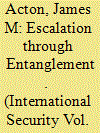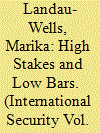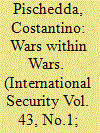|
|
|
Sort Order |
|
|
|
Items / Page
|
|
|
|
|
|
|
| Srl | Item |
| 1 |
ID:
161211


|
|
|
|
|
| Summary/Abstract |
Nonnuclear weapons are increasingly able to threaten dual-use command, control, communication, and intelligence assets that are spaced based or distant from probable theaters of conflict. This form of “entanglement” between nuclear and nonnuclear capabilities creates the potential for Chinese or Russian nonnuclear strikes against the United States or U.S. strikes against either China or Russia to spark inadvertent nuclear escalation. Escalation pressures could be generated through crisis instability or through one of two newly identified mechanisms: “misinterpreted warning” or the “damage-limitation window.” The vulnerability of dual-use U.S. early-warning assets provides a concrete demonstration of the risks. These risks would be serious for two reasons. First, in a conventional conflict against the United States, China or Russia would have strong incentives to launch kinetic strikes on U.S. early-warning assets. Second, even limited strikes could undermine the United States' ability to monitor nuclear attacks by the adversary. Moreover, cyber interference with dual-use early-warning assets would create the additional danger of the target's misinterpreting cyber espionage as a destructive attack. Today, the only feasible starting point for efforts to reduce the escalation risks created by entanglement would be unilateral measures—in particular, organizational reform to ensure that those risks received adequate consideration in war planning, acquisition decisions, and crisis decisionmaking. Over the longer term, unilateral measures might pave the way for more challenging cooperative measures, such as agreed restrictions on threatening behavior.
|
|
|
|
|
|
|
|
|
|
|
|
|
|
|
|
| 2 |
ID:
161212


|
|
|
|
|
| Summary/Abstract |
When rebel groups engage incumbent governments in war for control of the state, questions of international recognition arise. International recognition determines which combatants can draw on state assets, receive overt military aid, and borrow as sovereigns—all of which can have profound consequences for the military balance during civil war. How do third-party states and international organizations determine whom to treat as a state's official government during civil war? Data from the sixty-one center-seeking wars initiated from 1945 to 2014 indicate that military victory is not a prerequisite for recognition. Instead, states generally rely on a simple test: control of the capital city. Seizing the capital does not foreshadow military victory. Civil wars often continue for many years after rebels take control and receive recognition. While geopolitical and economic motives outweigh the capital control test in a small number of important cases, combatants appear to anticipate that holding the capital will be sufficient for recognition. This expectation generates perverse incentives. In effect, the international community rewards combatants for capturing or holding, by any means necessary, an area with high concentrations of critical infrastructure and civilians. In the majority of cases where rebels contest the capital, more than half of its infrastructure is damaged or the majority of civilians are displaced (or both), likely fueling long-term state weakness.
|
|
|
|
|
|
|
|
|
|
|
|
|
|
|
|
| 3 |
ID:
161210


|
|
|
|
|
| Summary/Abstract |
Realpolitik, the pursuit of vital state interests in a dangerous world that constrains state behavior, is at the heart of realist theory. All realists assume either that states engage in such behavior or, at the very least, are highly incentivized to do so by the structure of the international system. Classical realists remind us, however, that Realpolitik presupposes rational thinking, which should not be taken for granted. Some leaders act more rationally than others because they think more rationally than others. Research in cognitive psychology provides a strong foundation for classical realist claims that Realpolitik requires a commitment to objectivity and deliberation, a particular psychology that few leaders exhibit. A case study of Otto von Bismarck's role in German reunification demonstrates that rationality is the exception, rather than the norm. Even though Prussia was under enormous structural constraints that should have incentivized Realpolitik, the man who would become the Iron Chancellor was isolated because of his foreign policy views. Bismarck consistently disagreed with conservative patrons and allies at home, disagreements that can be reduced largely to his higher degree of rationality.
|
|
|
|
|
|
|
|
|
|
|
|
|
|
|
|
| 4 |
ID:
161213


|
|
|
|
|
| Summary/Abstract |
Why do rebel groups often fight each other when confronting a common, and typically stronger, enemy—namely, the government? Inter-rebel aggression is a calculated response by rebel groups to opportunities for expansion and to the threats confronting such groups. In particular, inter-rebel wars occur under the following conditions: (1) when a window of opportunity emerges allowing rebel groups to defeat coethnic rivals at low costs and thus achieve rebel hegemony, or (2) when rebel groups are confronted with a window of vulnerability, in which they experience a radical deterioration of power relative to that of coethnic rivals and then attempt to escape in a desperate military gamble. Both strict military considerations and ethnic identities shape the rebel groups' calculus. Coethnicity influences the threat perception of rebel groups and their ability to grow at the expense of rivals, thus providing both defensive and offensive motives for inter-rebel aggression. Because coethnic rebel groups want to mobilize and control the same ethnic communities, they are highly sensitive to immediate, intense conflicts of interest and see other coethnic rebel groups as serious threats. Moreover, coethnic rebel groups can generally expect to absorb the resources of defeated rivals, which in turn may improve their chances in the fight against the government. In-depth case studies of multiparty insurgencies in Ethiopia's Eritrea and Tigray provinces, based on interviews with former rebel leaders, strongly support the window of opportunity and vulnerability theory of inter-rebel war.
|
|
|
|
|
|
|
|
|
|
|
|
|
|
|
|
|
|
|
|
|